Other Voices, Other Bodies
Our own voice is our own most trusted familiar — more trusted than our own appearance, for which we at least need a mirror.
—Thomas Trummer. 1[1. “Voice and Void”, in Voice and Void ed. Thomas Trummer (Ridgefield: Aldrich Contemporary Art Museum, 2007), 11.]
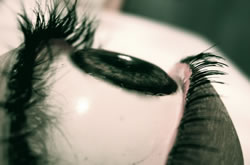
During my time as a vocal student in the early 2000s, I valued singing not only as a means of expression, but also as a way to know my body better. Through singing, I gained a newfound awareness of elements of my body I had previously taken for granted, and became sensitive to things like breathing, posture, as well as the pitch of my speaking voice during my day-to-day interactions. This awareness of my voice as an instrument transformed my perception; I came to appreciate my voice as a bordering point between my interior and exterior self. I also recognized the effect my body had on my voice — the voice’s interplay between “real” and “ideal” as a reflection of personal subjectivity.
My recent electroacoustic compositions use a full range of vocal sounds that include sparse instrumental accompaniments to human clicks, breath, stutters, growls and whistles. In these multi-channel works I attempt to find a balance between organic and inorganic vocals, addressing “voice” as a topic.
I favour electroacoustic production because the reproduction of the human voice with an electronic body creates an intriguing effect. The effect I speak of is the doubled disappearance of both the body of the absent performer, as well as the disappearance of the performer’s invisible stand-in, the stereo system. For example, no one would expect an opera singer’s “body” to be in the room once a compact disc were placed into the system for playback, but at the push of a button her voice reverberates around your living room and off your hardwood floor. This disconnection between voices and their bodies has become commonplace as playback technology becomes increasingly affordable, portable, and ubiquitous. The disappearance of sound-producing bodies has been ongoing since the creation of the phonograph in the late nineteenth century. This disappearance is further compounded by contemporary conditions that are causing the body of the technological stand-in to also disappear.
The technological stand-in for the sound-producing body is the non-performing, objective body of the recording playback device. The advent of increasingly small, affordable and portable digital music players has reduced the novelty of the playback device: whereas previous manifestations of this electronic body, such as the phonograph, had more of a revolutionary effect on listening, the impact of the separation of voice from body has been reduced and normalized in the listener’s consciousness. Furthermore, the attention given to the bodies of these devices is only sustained only as long the user deems the device to have novelty or social meaning. The disappearing physical body of the playback device is visible as recording formats become smaller and more convenient. These disappearances are conspicuously echoed in the design of home theatre systems — minimalist, receding bodies in black and silver that hover on the edge of an immersive experience like conspicuous gargoyles. I once encountered a salesman who gave me the following advice on colour selection for a home theatre system: “If you get the black model, the speakers disappear in the dark. But the silver ones — they float! While at one point in history the technological body of audio reproduction may have held more social or physical presence, the body of the music player is now small, receding, convenient, and immaterial as the sound it reproduces. In some cases the body of the sound playback device is further obscured by other technological bodies: cellular telephones, desktop computers, and car stereos now enfold the body of the musical playback device, rendering its body more invisible than ever.
The effect of this disconnect from both the body of the performer as well as its technological stand-in is two-fold. The first effect is the reinforcement of bodily tension when using and encountering the voice as a musical instrument without electronic buffer. The second effect is a condition where the listener is accustomed to ignore the technological body, and accepts the technological body as a default enabler for listening in day-to-day life. Perhaps as a result of these two conditions, singing voices are not heard as often in public or in our homes. But there are a variety of contemporary technological bodies for the voice to inhabit, which encourage the voice to re-emerge. Such environments include karaoke bars, reality-based idol competitions, and software such as the popular “I am T-Pain” auto tune iPhone application. 2[2. Ben Parr, “T-Pain iPhone App: 300,000 Downloads in Three Weeks,” Mashable: The Social Media Guide. 1 October 2009. This product is sold by Smule, a company founded by Dr. Ge Wang, Associate Professor at Stanford University at the Center for Computer Research in Music and Acoustics.] Cellular telephones, video chats, and Facebook profiles are personalized by individual presence and content, but physical structures are standardized. In these environments, one’s voice becomes synchronized with the body of the technology, creating strange new resonances in a body that is both displaced and invisible.
In my own art practice I use the human voice to call attention to the absent or truncated human body, presenting the viewer/listener with invisible mouths, tongues, and lungs as altered through electronic process. This has inspired me to embrace musical creation through a variety of media, including traditionally notated vocal scores, visual scores, video music, interactive sculpture, installation, and performance. Through this essay, I will first explore the voice and body as integral considerations in my practice, and later describe my musical work in visual and tactile media as articulations of the relationship between bodies of the audience and the body of the musical objects. This position uses the visual as a site of resistance against the doubled disappearance of the body in technologically enabled audio reproduction, encouraging an environment that resists the novel through hybridity, fragmentation, and a consideration of cyclical time.
So what is this voice that I speak of? In the first lesson of “Six Lessons on Voice and Meaning,” Mladen Dolar states that the sound of a voice can be singled out among an infinite array of acoustic phenomena due to its inner relationship with meaning. 3[3. In Voice and Void, ed. Thomas Trummer (Ridgefield: Aldrich Contemporary Art Museum, 2007), 31.] He later explains that this relationship to meaning can be extrapolated onto non-vocal sounds, such as drumming or the sound of animal voices — so long as the assumption can be made that the sound is linked to the aforementioned practice of communication. This unique voice is given specific harmonic overtones and timbre according to the shape of its vocal chords, and is coloured further by its surrounding visual and tactile resonating chamber — the body. After the voice has left the subject, additional reverberations colour the voice according to the physical space that the body inhabits. These containers within containers for sound are not only acoustic, but social.
When listening to a performer’s voice, the audience gains important information by regarding the body, obtaining information about the age, culture, and demeanor of the performer, as well as the environment within which the performer is making their music. In an essay titled “The Social Discipline of Listening”, Richard Leppert describes both performance and the act of listening as caught up in the materiality, culture and politics of the human body. Using examples from art history, architecture of the concert hall, and the conventions of musical form, Leppert reasons that the visual experience of musical production is crucial to musicians and audiences alike for locating and communicating the place of music within society and culture. This understanding of listening is understood as the result of mediations between ear and eye functioning within a “sonoric landscape”. 4[4. In Aural Cultures ed. Jim Drobnick (Toronto: YYZ Books, 2004), 20–21.] What is the effect upon the listener when the sonoric landscape contains only invisible and disappearing bodies? The portability of a playback device renders the listening environment arbitrary and user-specific — transporting the listener away from his body, and further still from a feeling of connection with the world around him. These effects mirror those of visually assistive technologies such as the camera and television, commodity objects which French Situationist Guy Debord describe as functioning by substituting images for reality. In response to Debord’s work Society of the Spectacle (1967), Philip Auslander observes that in the case of aural perception, the visual acts as a site of resistance against the commodity that divorces sound from evidence of its production. 5[5. Ibid., 151–156.] As such, the audio artist has a variety of aural, visual and social elements to consider, which are given more complexity when integrated with media such as video, interactive installation, or performance. Creative technological bodies and interfaces have power to disrupt the double-blind position of the technologically enabled listening experience, with potential to either call attention to the absent body of the musician/composer, or highlight the musician/composer’s body as extended by electronic prosthesis. 6[6. The visual is not the only tool for this kind of work: projects such as Yasunao Tone’s 1997 album Solo for Wounded CD (Label: Tzadik. Catalog#: TZ 7212. Released in 1997) consisted of the sounds of damaged audio CDs played on a CD player. Tone’s compact discs sang, cried and screamed in chorus: “we have bodies just as frail and fallible as yours,” referencing the physical without the necessity of spectacle or display.] This uncanny experience creates a useful discomfort, causing the listener to purposefully reconcile the voice with its relatively anonymous technological body. 7[7. The “uncanny” is a Freudian concept of an instance where something can be familiar, yet foreign at the same time, resulting in a feeling of it being uncomfortably strange. See an English translation of Sigmund Freud’s 1919 essay “Das Unheimliche” online. (Last accessed 31 May 2010.)] It is with consideration of this psychological tension that I investigate electroacoustic music composition through a variety of traditional and non-traditional methods.
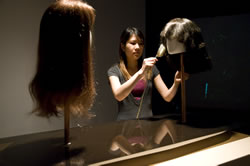

My first work created for interactive audio-sculpture format, Formants (2008), was created as a song about vanity in a technological context. I created two sculptures of abstracted female faces from fiberglass, and gave each its own unique human-hair wig. The two heads face one another, emerging from a single base/body that has two antique brushes attached to its base with brass chains.
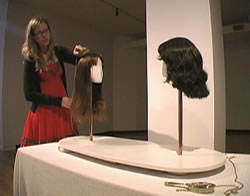

After Formants I began to research technology from an historical perspective, and became interested in non-electronic, obsolete technological artifacts. Forever is Forever (2009) is a love song that I wrote for gallery installation, consisting of two music boxes that originally played the popular song Theme from Love Story. Using strings, I suspended the two music boxes side-by-side in the air, and ripped out half of the notes from each box. In doing so I altered the boxes’ bodies, and created co-dependant musical relationships between the two wind-up machines. Because the “program” of a music box is printed on a circular cylinder, the linearity of standard notation is transformed into that of a constant return.
My use of the music box in this composition was inspired by a comment made on the empyre mailing list during a discussion of philosopher Roland Barthes’ book A Lover’s Discourse (1977), where Owen J. Ware observed:
This is the threat I see Barthes struggling with: the threat of love becoming clichés … it doesn't seem there is anything else to love than its repetition. So the force of repetition in love, the condition of possibility for love becoming banal, common-place, dead, is also the condition of possibility for its life and affirmation. 8[8. Discussion on empyre mailing list, 7 October 2008.]
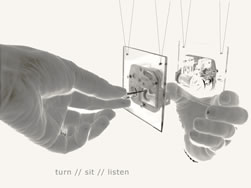
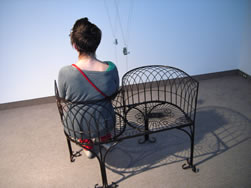
This object recreates the musical relationships of a popular love song by reflecting the unique physical movements of audience/performers who turn the music box keys. My intent was to create a musical duet that fuses the gap between past, present and future with two eternally desiring, mechanical subjects. Though this work is not electroacoustic, the melody and lyrics of the song that the music boxes play references the human voice as transferred to a technological body.
The paraphrasing of historical past within a contemporary, technological context is also mirrored in the sound component of my most recent work, Lucide (2010) which houses a new choral recording of Cantique de Jean Racine by Gabriel Fauré (1894). The four vocal parts were recorded separately as sung by three singers — myself, Gregory Muszkie, and Christina Willatt — and set into five different tracks which are manipulated independently by viewer interaction. Two of these five tracks are voices that were electronically created from the organic voices of Muszkie and Willatt. The final result is that of an electronic, virtual choir of human voices and artificial voices, all housed in a uniform, monolithic, body. The text, “Verbe égal au Trés-Haut,” is a paraphrase by French dramatist Jean Racine (Hymnes traduites du Bréviaire romain, 1688), which was taken from a 4th century hymn for Tuesday matins, Consors paterni luminis.
The robotic components of the installation consist of five handcrafted fiberglass eyes, which are embellished with acrylic paint, resin, and eyelashes made from human hair and bird feathers. These eyes are made to be touched — when a gallery viewer opens the eyes, a light sensor connected to an electronic circuit and computer activates audio from internal speakers. Rather than providing surveillance, or making recordings of the information give to them, these eyes are programmed to use incoming information to communicate through vocal song. The incorporation of organic source material into this work — the human voice, hand-painted retinas transcribed from living people, and the eyelashes — call attention to the psychological relationship between humans and their others as mirrored through dolls and automatons. Each of the five eyes in this sculpture can be opened and closed individually by the viewer to rearrange the song sung by the virtual choir — creating potential for solos, duets, trios, quartets, a full choir, or periods of silence. This element of touch is important to the final music created, a song within an object that is performed by whomever encounters the piece.
Lucide (2010) stems from a modernist fascination with technology, as well as nostalgia for a pre-Enlightenment world ruled by religious faith. This perspective is applied to both the electronic re-contextualization of the classic choral song, as well as the body housing the electronic and human voices. The design of the body was influenced by medieval Damask patterns, as well as the monolith from Stanley Kubrick’s film 2001: A Space Odyssey (1968), in my hopes to express an ambivalence between the firmament of tradition and an optimistic hope for an unknown future. For these reasons I find it necessary to associate my practice with traditions of music composition, to engage with historical practices of organizing sound.
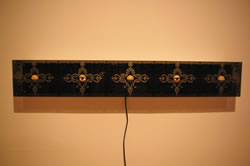
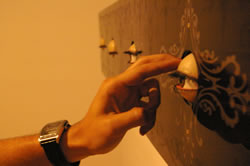
I find the opportunity to integrate social bodies and performance into the musical experience compelling — to use my voice as transformed through media-based composition as a point of connection with a reverberant audience. Calling attention to this musical/physical body as a social and physical amplifier, I often reference the disassembled human body in the musical interface, the flesh as fragmented, isolated, and extended through technological contexts. I do not aspire to fetishize technology, but do feel the need to comment on social developments that are in my immediate environment. I think that this is one of the many reasons why many artists choose to work in digital media. The development of relatively inexpensive technological components, highly documented software and hardware, and communities of individuals interested in alternative, open-source electronic interfaces also gives artists increasing amounts of freedom in this medium. Despite these developments, audiences have become so accustomed to electronic novelty as to enable the disappearance of many creative works of digital art into the fabric of popular consumption.
I believe that artists can address this environment of technological fetish by displacing voices creatively within technological as well as organic shells to call attention to the dissonance between organic and inorganic experience. By developing and employing a variety of media with sensitivity to these issues, artists can develop sophisticated experiences for listening that embrace technological bodies as extensions and mirrors of a subjective, human identity. For myself, and theorists such as Willard McCarty and Ann Weinstone, this is not technological work, but humanist. 9[9. I am primarily interested in the research of Ann Weinstone (which she describes as post-humanist) in her book Avatar Bodies: A Tantra for Posthumanism (Minneapolis: University of Minnesota Press, 2004). Willard McCarty has coined a term for this position which he calls “Humanities Computing”.] My hope is that continued innovation in technological musical production provides strategies that bring humans not only closer to their machines, but closer to each other, and in this regard I fantasize of a future environment that contains unforeseen couplings between electronic and non-electronic bodies — a playful and intimate place filled with strange vehicles for sonic expression.
Social top